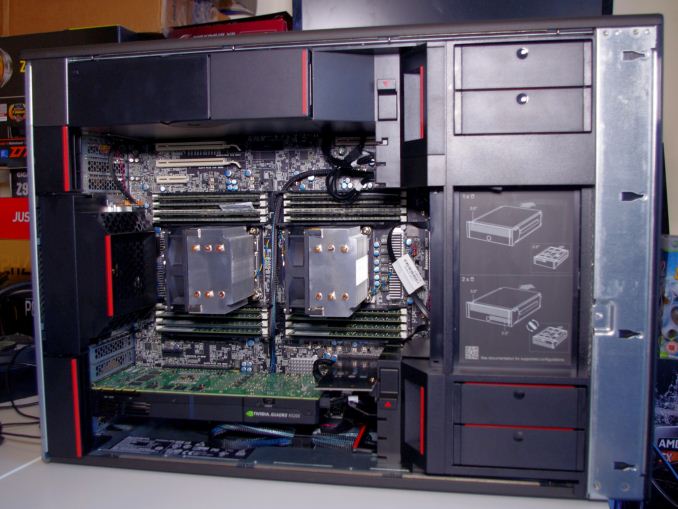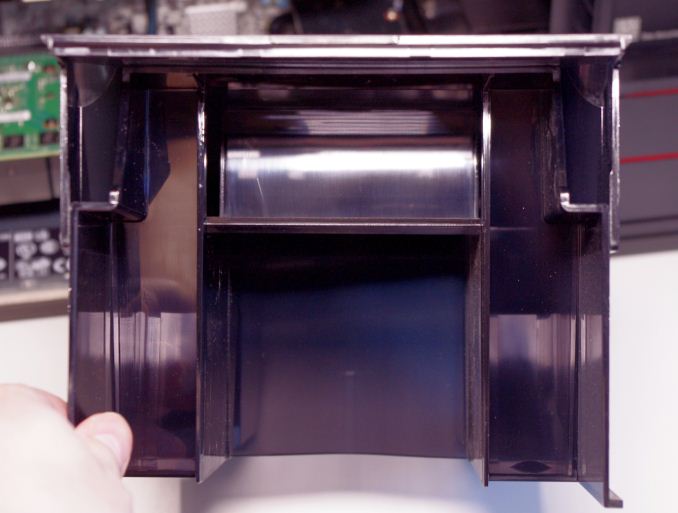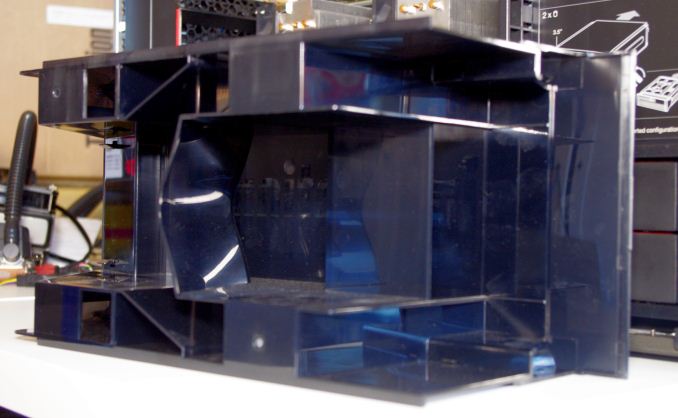The Lenovo ThinkStation P900 Workstation Review: Design 101
by Ian Cutress on May 6, 2015 7:00 AM ESTLenovo ThinkStation P900 Conclusion
As I mentioned in the introduction to the review, Lenovo is at an advantage here due to the fact that the P900 is the first high end workstation we've had in for review in quite a while. As a result it is difficult to compare the experience with the other major workstation OEMs and easy to get carried away in the positive aspects. In order to address the balance, both Dell and SuperMicro are in the process or organizing systems for us.
Despite this, Lenovo's design is pretty well done and kudos are deserved to the engineering and design teams around the P900 series. One of the key elements in workstation chassis design is the ability for system administrators to update and replace components to minimize downtime. Lenovo's design ensures that almost everything is easily replaceable, especially when it comes to drives, storage, power supplies and fans. In an attempt to minimize cabling, storage is provided either via the FLEX system or integrated into a backplane that supports both data and power. The drives for the backplane work with two drives apiece, allowing for 8 drives on the backplane and a further four PCIe devices on the FLEX connectors.
Perhaps we could point a finger and say that the PCIe devices are slightly harder to adjust, requiring a screwdriver at a minimum, but the system splits the PCIe lanes from both the processors allowing as much bandwidth as possible should multiple coprocessors be required. In order to facilitate these devices, the design also includes direct airflow through three regions - at the top and bottom the air is blown through the front, over the storage drives and through the PCIe devices then out the back. For the two CPUs in the middle, air is taken in the back and split by an air baffle into two. Each air stream then passes over an individual CPU, and the air is then directed around the ODDs and then out of the front of the case. Due to Lenovo's design, this all happens due to the arrangement of the hardware and at a relatively quiet volume. When you start enabling the power viruses the fans do kick in at a rate, but nothing unexpected for a workstation.
Performance wise, we have to grin and bear that some of our performance metrics are not particularly suited to dual processor designs. Thus despite the high end system provided with two 160W ten-core processors, sometimes for regular workloads a single processor performed noticeably faster. It even affected our SPECviewPerf numbers, despite having the better Quadro than our P300 review. That being said, I always recommend that users looking into dual processor systems know their workloads and memory requirements. If you have the software to take advantage, it always makes sense, and in our performance numbers that could take advantage of this we saw large gains over a single socket implementation especially when large amounts of DRAM are required.
One critical juncture that will be noted is the price of the unit we were sent for review. At over $16700 for a web store purchased unit, it seems at least +50% more expensive than a self-build. We saw this in our P300 review as well, to which Lenovo explained that web sales account for single digits in percentage of sales and most customers are direct b2b or to resellers that outfit with their own hardware. The prices online, Lenovo has stated, means that they are not in direct competition with their resellers and b2b customers are directed to the regional representatives for pricing.
Thus despite the cost, the P900 is designed to be Lenovo's halo workstation product in a sea of potential contenders. From a purely design point of view, I loved poking and prodding with the chassis to see how everything connected and what went where. Whatever the end user might think, the sysadmin should find upgrading and replacing components easy.













61 Comments
View All Comments
zavrtak - Friday, May 29, 2015 - link
Pro users should have their own backup solution already in place and in most cases those solutions will be network driven anyway. Adding a secondary physical backup drive is literally pointless for professional use. Some self employed hobbyist that runs his business without any it-consulting nor it expertise does not really qualify for "pro user" imho, though I hear since 30 years funny stories about those, and even today they are usually better off with just using apple. ;-)Besides, naturally IBM has nothing to do with a Lenovo system ;-)
LeahLambert - Wednesday, May 6, 2015 - link
thats greatFreakie - Wednesday, May 6, 2015 - link
I'm not hip to this workstation myself. They are betting on IT departments wanting some sort of fancy interior which, at least in my experience, is just not the case. While it may be fun to poke around and see what everything does, it's only neat once and after that it gets old. From looking at these pictures, there are definitely quite a few parts that would need removing (and the need to figure out how to remove) to replace other things. To be honest it's looks like an annoying design for and IT department.In contrast I got to poke around a couple of Dell's latest Precision workstation designs last year (they've had this design for nearly two years now actually) and it looks much easier to service than this Lenovo. This Lenovo simply has too many movable parts to service. We don't care about baffles or fans sliding in and out. We care about opening it up and being able to remove the power supply and only the power supply. Being able to reach all the DIMM slots without having to remove anything else. We really want to be able to take out just the part we want and that's it. Putting things in the way of that just frustrates and complicates. Having everything be obvious and right in front of you for removal is usually what you want.
It's a really cool looking design, and for a personal workstation it does look genuinely interesting but when I can configure a Dell for my AutoCAD guys who need new computers, with the same specs and warranty, for $5,000 less (ordering online too of course) then I'm going to instantly chose the Dell and forget about marketing terms like "baffles" because their department doesn't need $5,000 in marketing and I don't actually NEED fancy internals to do any work that the computer needs in the future. And given that many companies/government agencies bill computers to the account of the department it is going to, not the IT department, then it is sort of the last nail in the coffin for deciding on this purchase and I would imagine that where they will see most of their volume will be small business, not the large entities that bring in large orders.
mapesdhs - Wednesday, May 6, 2015 - link
I hear you about internals being a pain sometimes. I recently refurbed an old Dell 1-CPU S775 system, it was a nightmare to take apart, whereas a T7500 is much easier to deal with. Good to hear newer Dells are built nicely too, and you're spot on about the cost difference being a deciding factor for most potential buyers; $5K is kinda huge at this level.Ian.
mapesdhs - Wednesday, May 6, 2015 - link
Btw, their excuse for the online pricing setup reminds me of what SGI used to say about such things, whereas in reality (certainly for SGI back then) it would have been so much better if one could have ordered direct, without going through a reseller who often just ripped people off with huge markups.Ian.
Freakie - Wednesday, May 6, 2015 - link
Oh man I hear you too, those older Dells are such a pain. But the newer ones are definitely better even than the T7500's; the cable routing in the T7500 is a nightmare. If the unit wasn't under warranty anymore I'd just cut the cables when replacing the PSU because I couldn't be bothered cutting my hands up getting them out and then again going in all the crannies.Direct ordering is definitely way better than through partners. Not just the price but the support alone is worth it, especially with Dell. I might not like their consumer stuff too much but managing 500+ computers and their service status/history is actually not too bad with them. It's not easy providing so much support which is why some companies prefer to sell most of their volume through resellers because then it's the reseller's job to provide support, not the manufacturer. And I don't exactly have fond feelings for reseller support.
mfred - Friday, May 8, 2015 - link
Their comment about web prices is kind of BS. At least for laptops, they constantly undercut us and we're a partner. I find it somewhat difficult to sell Lenovo because they do sell cheaper on their website than they do in distribution. The cost will be maybe $5 less in disty than what's listed on their website.We do mostly Supermicro/Dell for workstations though, so I can't comment on those prices.
Samus - Wednesday, May 6, 2015 - link
IT departments want support. Lenovo does not equal support.GTVic - Wednesday, May 6, 2015 - link
It doesn't really pay to spend this much time on criticizing based on a picture. Having used Lenovo Thinkstations in the past I can be confident that this is largely a tool free design, everything snaps in and is designed to be fairly easy to service.Samus - Wednesday, May 6, 2015 - link
That's great for Lenovo technicians because real IT departments don't actually service the equipment, it's all done under warranty and once its out of warranty, the equipment is EoL'd and cycled out. No IT department buys equipment based on how easy it is to service. They buy based on support, reliability, and price.